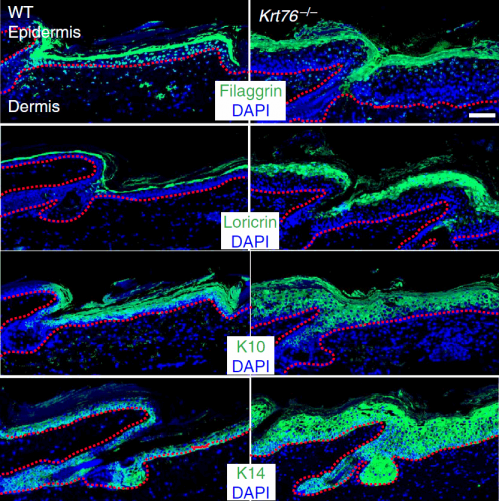A genetic analysis of skin development

(Medical Xpress)—Researchers report the first comprehensive analysis of genes that affect a single tissue. Genes don't act in isolation and it is only by studying the effects of many genes that scientists can gain a more accurate and holistic view of the complex biology of tissues.
The team found 50 genes that affect development of skin in the mouse, including nine already known to play a role in human disease. Around half of the genes that affect skin were not active in skin, but in other tissues, showing how important it can be to take an approach to discovery that is unbiased by preconceptions of which genes might affect function in which tissue.
The team inactivated genes in the mouse and looked for consequences on normal body function and disease: the focus of this study was on skin.
"This is one of the first studies to look at one organ at this scale, with samples from over 530 genes," says Dr Ramiro Ramirez-Solis, Head of Mouse Pipelines at the Wellcome Trust Sanger Institute. "Such a large-scale study allows us to look at genes that might not otherwise have been thought to be associated with skin development.
"We have not focused on those genes whose biology suggests they might be implicated in normal skin function or in disease of the skin. Rather, we have taken an objective, evidence-based approach to uncover genes whose role in skin development was not known."
The team looked at 530 genes: remarkably, mutations in one in eleven had an effect on skin development. The team were able to detect effects on skin that ranged from changes to fur or paw colour, to the arrangement of the individual hair follicles, to the flakiness of the skin.
"We found nine genes that we knew already are associated with human diseases that have a skin component, and these mouse models could be a new means of studying the diseases or finding treatments," says Professor Fiona Watt, Director of the Centre for Stem Cells and Regenerative Medicine, King's College London. "We also found new mutations that could help us to understand skin conditions that affect patients and perhaps help to develop new diagnostics."
To validate the screening approach, the team looked in detail at three genes whose mutations are known to be involved in human disease. In one case, mutation in a gene called Myo5A causes effects in the mouse that mimic Griscelli syndrome. The team also found effects for mutations in a related gene, Myo7a, suggesting that this, also, might play a role in human skin disease.
In one case, skin development in mutant mice was influenced by diet: mice fed on a high-fat diet showed less effect of the mutation than those on normal feed.
"Surprisingly, some of the 50 genes that cause skin conditions in the mouse are not active in skin tissue," says Professor Karen Steel from the Wolfson Centre for Age-Related Diseases, King's College London and the Sanger Institute. "These will be important in understanding human disease and would probably not be found without such a large-scale project.
"This study shows the value of unbiased examination of as many genes as possible, rather than selecting only those thought to be involved in skin development or maintenance."
Such a large array of newly identified genes should improve our understanding of human skin biology and improve clinical care. All of the information and resources generated are freely available so that other scientists can easily follow up on these new discoveries.
More information: "Novel skin phenotypes revealed by a genome-wide mouse reverse genetic screen." Liakath-Ali K, Vancollie VE, Heath E, Smedley DP, Estabel J, Sunter D, Ditommaso T, White JK, Ramirez-Solis R, Smyth I, Steel KP and Watt FM. Nature Communications 2014;5;3540















